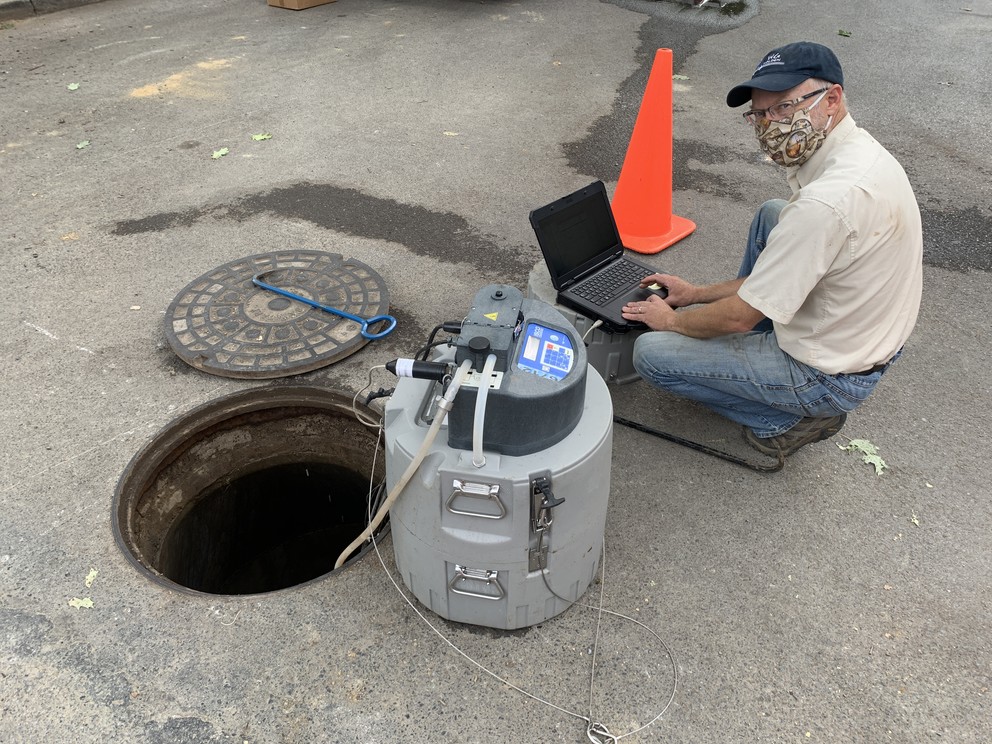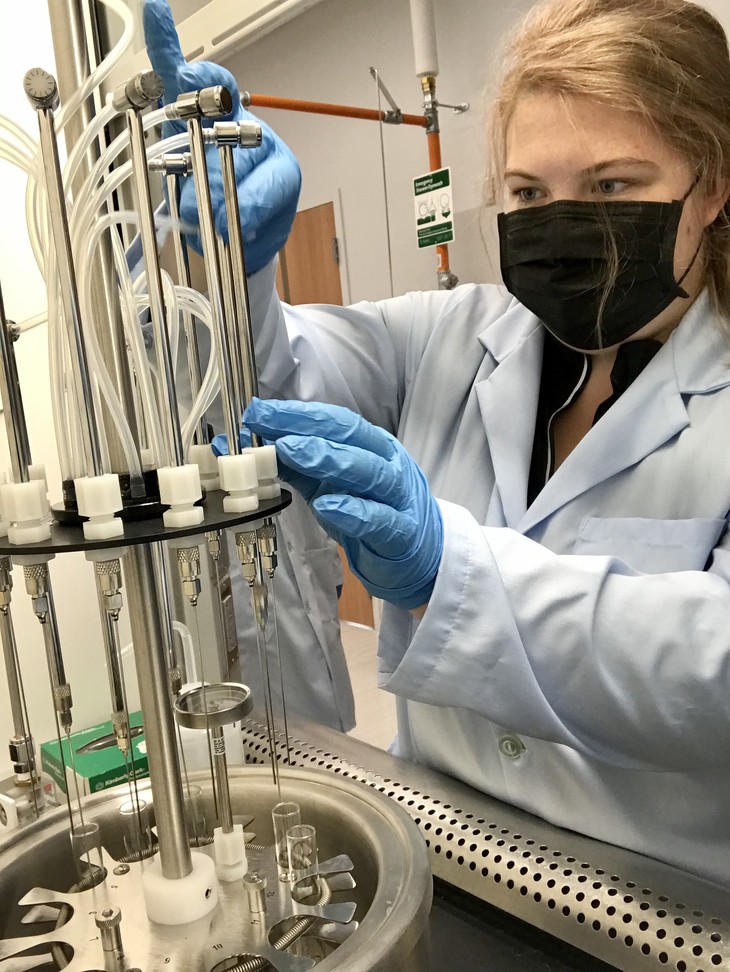
Bob Heine (B.Arch. '91), a technician at WG Malden, installs a flow meter into Penn State's sewage network. IMAGE: MICHAEL SHREVE, PENN STATE
Wastewater sampling may give advanced warning of potential COVID-19 outbreaks
Posted on September 21, 2020UNIVERSITY PARK, Pa. — Wastewater sampling for coronavirus on campus and in the surrounding community could alert University decision makers to a potential outbreak several days before individuals exhibit symptoms of an infection. The initiative — part of Penn State’s multilayered approach to test, monitor and mitigate for COVID-19 — could enable leaders to take swift actions to minimize the virus’s spread with the goal of helping to protect the health and safety of the community.
“Research has shown that people infected with SARS-CoV-2 shed the virus in their feces,” said Heather Preisendanz, associate professor of agricultural and biological engineering, who initiated the wastewater monitoring effort. “As a result, sampling wastewater for the virus has the potential to give an overall snapshot of its prevalence in the community, as well as identify general locations where the virus is present.” Data are shared daily with Penn State’s COVID-19 Operations Control Center and regularly with University leadership.
Andrew Read, director of the Huck Institutes of the Life Sciences, noted that wastewater monitoring also can be done at relatively low cost, allowing leaders to be more strategic in their use of more expensive, yet more precise, testing methods. He said, “The virus concentrations we are seeing are consistent with what the University is finding through individual testingand demonstrate that wastewater sampling has the potential to serve as an indicator of the virus’s presence on campus.” Read cautions, “We still have more work to do to understand the relationship between virus concentrations in the wastewater and confirmed COVID-19 cases.”
Making Sense of Complex Data
With funding from the Institute for Sustainable Agricultural, Food, and Environmental Sciences in the College of Agricultural Science; the Huck Institutes of the Life Sciences; and the Office of the Provost, the interdisciplinary team, in collaboration with David Swisher, operations engineer at Penn State’s Office of the Physical Plant, is sampling wastewater at the University’s main Wastewater Treatment Plant (WWTP), as well as some upstream locations, including near some residence halls on campus at University Park. The researchers are also partnering with Cory Miller, executive director of the University Area Joint Authority (UAJA), to monitor wastewater from the larger State College community.
“By adding wastewater monitoring to the University’s individual testing and contact tracing efforts, we hope to get a better understanding of what the virus is doing and take actions to minimize community spread,” said Read.
Tom Richard, director of the Institutes of Energy and the Environment, explained that although wastewater monitoring has many benefits, including enabling researchers to see whether SARS-CoV-2 is increasing or decreasing in a specific location, there are challenges in correlating the measured virus concentrations with the number of COVID-19 cases.
“Individuals shed more or less virus through their feces depending on the severity of their infection and how long they have been infected; the amount of shedding can vary from person to person by an order of magnitude,” he said. “Similarly, some people suffer from respiratory symptoms but never get the virus in their gastrointestinal systems. And while there is very little hard data about virus shedding patterns for people who are asymptomatic, indications are that some of those people are also shedding the virus.”

Exact correlations are also difficult because the number of people on campus and their water use fluctuates over the course of a day or week. For example, an increase in the concentration of virus detected in wastewater samples could mean there has been an increase in on-campus incidence, or it could mean that people are coming in from off campus and using the toilets because they are taking once- or twice-a-week in-person classes.
“All of these variables can substantially affect our inferences, so it’s important that we try to really understand them,” said Justin Silverman, assistant professor of information sciences and technology and a co-hire of the Institute for Computational and Data Sciences. To that end, Silverman is building statistical tools using techniques from a field called Bayesian time series analysis, to account for the variability and uncertainty in the system. “Our goal is to try to get a sense of what the concentration of the virus is at any given time from these very noisy data,” he said.
Silverman said he is consulting with researchers at other universities who are also attempting to set up wastewater monitoring programs. “I am making all of the modeling and tools that I am building available to anyone who can use them,” he said. “This is an extremely difficult task, and we are all better off when we share strategies that work.”
Laying the Groundwork
To collect the wastewater samples, the team first had to locate the sewer system access points from which to sample the wastewater. “Penn State has 18 miles of underground pipes, carrying about 1.6 million gallons of wastewater per day to the Wastewater Treatment Facility,” said Swisher. “There are 900 manholes to access this wastewater.”
Swisher helped the team identify the best manholes to target for sampling and assisted with setting up flow meters to determine the volume of water passing through, as well as collection devices programmed to collect water samples every five minutes for 24 hours. The team has five samplers installed and is about to receive another eight on loan from USDA Agricultural Research Service watershed scientists co-located at the University Park campus.
Swisher said he frequently works with scientists to manage Penn State’s wastewater system, which is run as a “Living Filter,” meaning it uses natural methods to recycle and reuse the water. “This project to monitor wastewater for the coronavirus is another good example of how our people in operations collaborate with scientists to solve problems that affect both the University and the local community,” he said.
Michael Shreve, a postdoctoral associate in Richard’s lab, is leading the daily sampling effort and using tracer studies and data from the flow meters to try to understand fluctuations in flow volumes, speed, and mixing of water from each individual flush, all of which influence concentrations of the virus’s genetic material collected by the sampler and how the data are interpreted.
Matt Jones, a research assistant in Read’s lab, analyzes the genetic material from the samples, as well as additional samples collected at the WWTP and UAJA. Specifically, Jones uses methods that he developed and adapted to concentrate and extract virus genetic material from the water. Next, he uses a technique, called polymerase chain reaction, to amplify the genetic material to the level of detection and records the concentration of virus per milliliter of water to track the rate of increase in the concentration over time.
Understanding Environmental Impacts
In addition to monitoring for SARS-CoV-2, Preisendanz, assisted by graduate research assistants Olivia Mroczko and Kathryn Hayden, is examining wastewater concentrations of pharmaceuticals, such as pain medications, fever reducers and therapeutic compounds.
“We know that some pharmaceuticals can persist through wastewater treatment plants and can end up in streams where there is potential for them to impact aquatic ecosystems,” said Preisendanz. “If COVID-19 cases become prevalent in our community, we may see higher concentrations of pharmaceuticals in our wastewater treatment plant and possibly in our streams. Our hope is that by considering different types of data, we can gain a better understanding of not only the prevalence of COVID-19 in the population, but also its potential impact on ecosystems.”
Richard noted that the team is not finding any evidence that the SARS-CoV-2 virus itself is passing through the wastewater treatment plants into the environment. “While we can detect genetic material from fragments of the virus in raw sewage flowing into the treatment facility, prior studies have found that these virus fragments in raw wastewater influent are not infectious,” he said. “Moreover, we have tested more than 20 samples of the treated water discharged from the plant and were not able to detect any fragments of virus in any of those samples. It is comforting to know that conventional wastewater treatment is very effective at destroying virus genetic material.”
Long-Term Strategy
Richard noted that if the initiative is successful at University Park, Penn State may consider expanding it across the Commonwealth campuses at a later date. He said that the team also hopes to one day assist other facilities in the region, including elderly care facilities and prisons.
Read added that the efforts the team is making today could help in the long term. “Wastewater monitoring provides a cost-effective way of monitoring for things that are rare; for example, polio is monitored in this way throughout the world,” said Read. “One day, SARS-CoV-2 will also become rare, or at least less common, and wastewater monitoring will likely continue for this virus. Right now, however, by adding wastewater monitoring to the University’s individual testing and contact tracing efforts, we hope to get a better understanding of what the virus is doing and take actions to minimize community spread.”
— By Sara LaJeunesse
—
